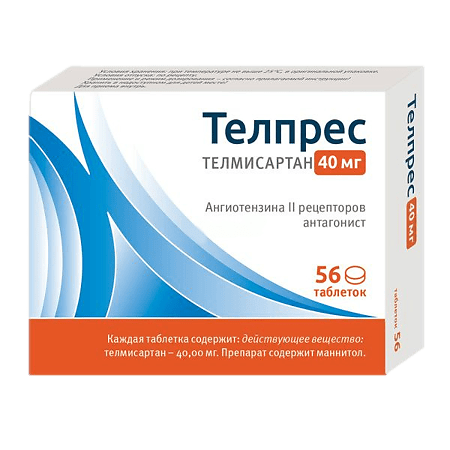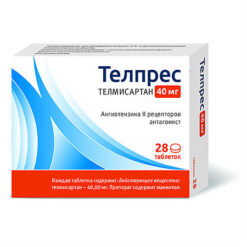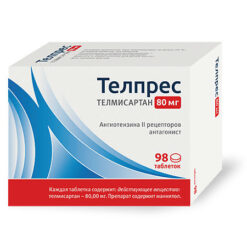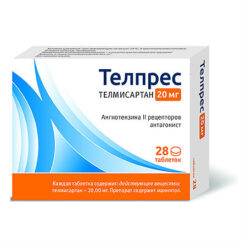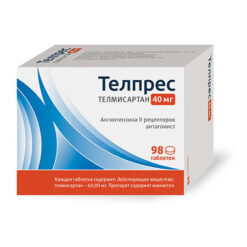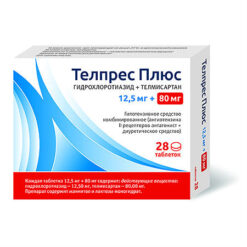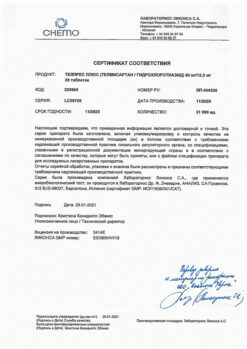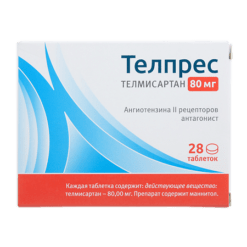No products in the cart.
Telprez, tablets 40 mg 56 pcs
€16.45 €13.71
Description
Telmisartan is a specific angiotensin II receptor antagonist (type AT1) effective when taken orally. It has high affinity for the AT1 subtype of angiotensin II receptors through which the action of angiotensin II is realized.
It displaces angiotensin II from binding to the receptor with no agonist effect against this receptor. Telmisartan binds only to the AT1 subtype of the angiotensin II receptor. The binding is long-lasting. It has no affinity for other receptors including AT2 receptor and other less studied angiotensin receptors.
The functional significance of these receptors as well as the effect of their possible overstimulation by angiotensin II whose concentration increases with telmisartan administration has not been studied. Reduces blood aldosterone concentration does not inhibit plasma renin and does not block ion channels. Telmisartan does not inhibit angiotensin-converting enzyme (kinininase II) (an enzyme that also destroys bradykinin).
Hence, an increase in bradykinin-induced side effects is not expected.
In patients with arterial hypertension, telmisartan at a dose of 80 mg completely blocks the hypertensive effects of angiotensin II. The onset of antihypertensive action is noted within 3 hours after the first oral administration of telmisartan. The action of the drug persists for 24 hours and remains significant up to 48 hours. A pronounced antihypertensive effect usually develops 4 weeks after regular use.
In patients with arterial hypertension, telmisartan lowers systolic and diastolic blood pressure (BP) without affecting heart rate (HR).
In case of abrupt telmisartan withdrawal BP gradually returns to baseline levels without development of “withdrawal” syndrome.
Pharmacokinetics:
Intake
In oral administration, it is rapidly absorbed from the gastrointestinal tract. Bioavailability is about 50%. When taken concomitantly with food, the decrease in AUC (area under the curve “concentration-time”) ranges from 6% (at a dose of 40 mg) to 19% (at a dose of 160 mg). Three hours after ingestion, plasma concentrations level off regardless of food intake.
Distribution
The binding to plasma proteins is 995% mainly to albumin and alpha-1 glycoprotein. Average apparent volume of distribution at equilibrium concentration is 500 l.
Metabolism
Metabolized by conjugation with glucuronic acid. The metabolites are pharmacologically inactive.
Elimination
The elimination half-life (T1/2) is more than 20 hours. Excretion through the intestine unchanged kidney excretion is less than 2% of the administered dose. Total plasma clearance is high (900 ml/min) compared to “hepatic blood flow” (about 1500 ml/min).
Pharmacokinetics in special patient groups
Gender differences
There is a difference in plasma concentrations in men and women. Cmax (maximum concentration) and AUC were approximately 3 and 2 times higher in women compared to men, respectively, with no significant effect on efficacy. No dose adjustment is required.
Elderly patients
The pharmacokinetics of telmisartan in elderly patients does not differ from that in younger patients. No dose adjustment is required.
Patients with impaired renal function
In patients with mild to moderate impaired renal function, no dose adjustment of telmisartan is required.
In patients with severe renal impairment and patients on hemodialysis, a lower starting dose of 20 mg daily is recommended.
Telmisartan is not excreted by hemodialysis.
Patients with impaired hepatic function
Pharmacokinetics studies in patients with hepatic impairment have shown an increase in the absolute bioavailability of telmisartan to almost 100%.
The T1/2 is not altered in hepatic insufficiency. In patients with mild to moderate hepatic impairment (Child-Pugh class A and B) the daily dose of the drug should not exceed 40 mg.
Indications
Indications
– Arterial hypertension;
– Reduction in cardiovascular morbidity and mortality in patients aged 55 years and older with a high risk of cardiovascular disease.
Active ingredient
Active ingredient
Composition
Composition
Each 40 mg tablet contains:
the active ingredient: telmisartan – 40.00 mg;
excipients:
sodium hydroxide – 3.40 mg,
povidone-K25 – 10.80 mg,
meglumine – 12.00 mg,
/p>
mannitol – 163.80 mg,
magnesium stearate – 4.00 mg,
crospovidone – 6.00 mg
How to take, the dosage
How to take, the dosage
Orally, regardless of meals.
Hypertension
The initial recommended dose of Telprez is 1 tablet (40 mg) once daily. In cases when therapeutic effect is not achieved the maximum recommended dose of Telprez may be increased to 80 mg once daily. When deciding to increase the dose it should be taken into account that the maximum antihypertensive effect is usually achieved within 4-8 weeks after the start of treatment.
Lower cardiovascular morbidity and mortality
The recommended dose is 1 tablet of Telprez 80 mg once daily.
In the initial period of treatment, monitoring of blood pressure (BP) may require correction of antihypertensive therapy.
Renal dysfunction
In patients with severe renal dysfunction and patients on hemodialysis, experience with use is limited. In these patients the recommended starting dose is 20 mg daily. No dose adjustment is required in patients with mild to moderate renal impairment.
Hepatic impairment
In patients with mild to moderate hepatic impairment (Child-Pugh grades A and B, respectively) the daily dose of Telpras should not exceed 40 mg.
Elderly patients
Dose adjustment is not required in elderly patients.
Interaction
Interaction
Telmisartan may increase the antihypertensive effect of other antihypertensive agents. Other types of interactions of clinical relevance have not been identified. Combined use with digoxin warfarin hydrochlorothiazide glibenclamide ibuprofen paracetamol simvastatin and amlodipine does not lead to clinically significant interactions.
Double blockade of the renin-angiotensin-aldosterone system (RAAS).
The concomitant use of telmisartan with aliskiren is contraindicated in patients with diabetes mellitus or renal insufficiency (FFR less than 60 ml/min/173 m2 body surface area) and is not recommended in other patients. Simultaneous use of telmisartan and AG1F inhibitors is contraindicated in patients with diabetic nephropathy.
The data of clinical studies showed that dual RAAS blockade due to combined use of ACE inhibitors ARA II or aliskiren is associated with increased incidence of adverse events such as hyperkalemia and renal dysfunction (including acute renal failure) compared to use of a single drug acting on RAAS.
The risk of hyperkalemia may increase when combined with other medications that can cause hyperkalemia (potassium-containing supplements and salt substitutes containing potassium and potassium-saving diuretics (spironolactone eplerenone triamterene or amiloride) non-steroidal anti-inflammatory drugs (NSAIDs including selective cyclooxygenase inhibitors-2 (COX) inhibitors) heparin immunosuppressants (cyclosporine tacrolimus trimethoprim).
If necessary against a background of documented hypokalemia, coadministration should be performed with caution and plasma potassium should be monitored regularly.
Digoxin
The co-administration of telmisartan with digoxin showed a 49% increase in mean plasma Cmax of digoxin and a 20% increase in minimum concentration. Plasma digoxin concentrations should be carefully monitored at the start of treatment for dose selection and discontinuation of telmisartan treatment to maintain them within the therapeutic range.
Kalium-saving diuretics or potassium-containing supplements
Angiotensin II receptor antagonists such as telmisartan reduce diuretic-induced potassium loss. Potassium-saving diuretics such as spironolactone eplerenone triamterene or amiloride potassium-containing supplements or salt substitutes may result in a significant increase in plasma potassium. If concomitant use is indicated because there is documented hypokalemia, they should be used with caution and with regular monitoring of plasma potassium.
Lithium preparations
The co-administration of lithium preparations with ACE inhibitors and ARAII inhibitors including telmisartan has resulted in reversible increases in plasma lithium concentration and its toxic effects. Careful monitoring of plasma lithium concentrations is recommended if this combination of drugs is necessary.
Non-steroidal anti-inflammatory drugs (NSAIDs)
NSAIDs (including COX-2 inhibitors and non-selective NSAIDs in doses used for anti-inflammatory treatment) can decrease the antihypertensive effect of APAII.
In some patients with impaired renal function (e.g. dehydrated elderly patients with impaired renal function) coadministration of APAII and cyclooxygenase-2 inhibitors may lead to further impairment of renal function including development of acute renal failure which is generally reversible.
To this end, coadministration should be used with caution, particularly in elderly patients. Adequate fluid intake should be ensured, and renal function parameters should be monitored at the start of co-administration and periodically thereafter.
Diuretics (thiazide or loop diuretics)
Previous treatment with high doses of diuretics such as furosemide (loop diuretic) and hydrochlorothiazide (thiazide diuretic) may lead to hypovolemia and risk of arterial hypotension at the start of telmisartan treatment.
Other antihypertensive agents
The effects of telmisartan may be enhanced by the combined use of other antihypertensive drugs. Based on the pharmacological properties of baclofen and amifostine it can be assumed that they will enhance the therapeutic effect of all antihypertensive agents including telmisartan.
In addition, orthostatic hypotension may be exacerbated when taking alcohol barbiturates narcotics or antidepressants.
Corticosteroids (for systemic use)
Corticosteroids impair the effects of telmisartan.
Special Instructions
Special Instructions
Hepatic disorders
The use of Telpras is contraindicated in patients with cholestasis with biliary obstruction or severe hepatic impairment (Child-Pugh class C) (see section “Contraindications”) since telmisartan is mainly excreted with bile. These patients are thought to have reduced hepatic clearance of telmisartan.
In patients with mild to moderate hepatic impairment (Child-Pugh grades A and B), Telpras should be used with caution (see section “Caution”).
Renovascular hypertension
The treatment with drugs acting on the RAAS in patients with bilateral arterial stenosis or arterial stenosis of the only functioning kidney increases the risk of severe arterial hypotension and renal failure.
Kidney dysfunction and renal transplantation
In patients with impaired renal function, periodic monitoring of plasma potassium and creatinine is recommended during use of Telprez. There is no experience in clinical use of Telprez in patients with recent kidney transplantation.
Decreased circulating blood volume
Symptomatic arterial hypotension especially after the first administration of Thelprez may occur in patients with decreased RBC and/or plasma sodium content on the background of previous treatment with diuretics limiting intake of table salt diarrhea or vomiting. Such conditions (fluid and/or sodium deficiency) should be eliminated before starting the drug Telprez.
Double blockade of the renin-angiotensin-aldosterone system
The concomitant use of telmisartan with aliskiren is contraindicated in patients with diabetes mellitus or renal impairment (glomerular filtration rate less than 60 ml/min/173 m2) (see “Contraindications”).
The concomitant use of telmisartan and ACE inhibitors is contraindicated in patients with diabetic nephropathy (see section “Contraindications”).
As a result of inhibition of the RAAS the following have been noted: arterial hypotension fainting hyperkalemia and renal dysfunction (including acute renal failure) in predisposed patients especially when several drugs also acting on this system are used together. Therefore, dual RAAS blockade (e.g. with telmisartan with other RAAS antagonists) is not recommended.
In cases when vascular tone and renal function are dependent predominantly on the activity of RAAS (e.g., in patients with chronic heart failure or renal diseases including renal artery stenosis or stenosis of artery of single kidney) the administration of agents acting on this system may be accompanied with development of acute arterial hypotension hyperazotemia oliguria and in rare cases of acute renal failure.
Primary aldosteronism
In patients with primary aldosteronism, treatment with antihypertensive drugs that function by inhibiting the RAAS is generally ineffective.
Aortic and mitral valve stenosis hypertrophic obstructive cardiomyopathy
Cautious use of Telpras (as well as other vasodilators) should be used in patients with aortic or mitral stenosis and hypertrophic obstructive cardiomyopathy.
Hyperkalemia
The administration of drugs acting on the RAAS may cause hyperkalemia. In elderly patients with renal insufficiency or diabetes patients also taking medications that increase plasma potassium and/or patients with comorbidities hyperkalemia can lead to death.
The risk-benefit ratio should be evaluated when deciding on concomitant use of drugs acting on the RAAS.
The main risk factors for hyperkalemia that should be considered are:
– diabetes mellitus renal insufficiency age (patients older than 70 years);
– combination with one or more drugs acting on the RAAS and/or potassium-containing food supplements. Drugs or therapeutic classes of drugs that can cause hyperkalemia are salt substitutes containing potassium saving diuretics ACE inhibitors angiotensin II receptor antagonists non-steroidal anti-inflammatory drugs (NSAIDs including selective COX-2 inhibitors) heparin immunosuppressants (cyclosporine or tacrolimus) and trimethoprim;
– intercurrent diseases especially dehydration acute heart failure metabolic acidosis impaired renal function cytolysis syndrome (e.g. acute limb ischemia rhabdomyolysis extensive trauma).
Patients at risk should have their plasma potassium carefully monitored (see section “Interaction with other medicinal products”).
Ethnic differences
The ACE inhibitors telmisartan and other ARAIIs appear to be less effective in lowering blood pressure in black patients than in other races, possibly due to a greater predisposition to decreased renin activity in this patient population.
Other
As with other antihypertensives, excessive BP lowering in patients with ischemic cardiomyopathy or ischemic heart disease can lead to myocardial infarction or stroke.
Contraindications
Contraindications
– Hypersensitivity to the active ingredient or excipients of the drug;
– Pregnancy;
– Breast-feeding period;
– Obstructive biliary tract disease;
– Severe hepatic impairment (Child-Pugh class C);
The concomitant administration of – Concomitant use of Telprez with aliskiren in patients with diabetes and/or impaired renal function (glomerular filtration rate less than 60 ml/min/173 m2);
– Concomitant use of ACE inhibitors in patients with diabetic nephropathy;
– Age
Side effects
Side effects
In general, the incidence of adverse reactions noted for telmisartan is comparable to that of placebo. The observed incidence of adverse effects did not correlate with the gender, age, or race of patients. World Health Organization (WHO) adverse reaction frequency classification: Very common (>1/10); common (>1/100 to <1/10); infrequent (>1/1000 to <1/100); rare (>1/10 000 to <1/1000); very rare (<1/10 000); frequency unknown (the incidence could not be determined from available data).
Infectious and parasitic diseases:
infrequent: upper respiratory tract infections including pharyngitis and sinusitis urinary tract infections (including cystitis);
unknown frequency: sepsis including fatal sepsis.
Disorders of the blood and lymphatic system:
infrequent: anemia;
rare: thrombocytopenia;
unknown frequency: eosinophilia.
Mental disorders:
infrequent: depression; rarely: anxiety.
Nervous system disorders:
infrequent: insomnia syncope vertigo; rare: syncope.
Visual organ disorders:
rarely: visual disturbances.
Cardiac disorders:
infrequent: bradycardia; rare: tachycardia.
Vascular disorders:
infrequent: marked decrease in BP* orthostatic hypotension;
* often observed in patients with controlled BP who were treated with telmisartan to reduce risk of cardiovascular mortality in addition to standard treatment.
Disorders of the respiratory system of the thorax and mediastinum:
infrequent: dyspnea cough.
Gastrointestinal disorders:
infrequent: abdominal pain diarrhea dyspepsia flatulence vomiting;
rarely: stomach upset discomfort dry oral mucosa liver function disorders/liver disease.
Disorders of the immune system:
Rarely: hypersensitivity angioedema (including fatal); unknown frequency: anaphylactic reactions.
Skin and subcutaneous tissue disorders
infrequent: hyperhidrosis itching skin rash;
rare: erythema drug rash toxic skin rash eczema unknown frequency: urticaria.
Musculoskeletal and connective tissue disorders: infrequent: myalgia back pain (e.g. sciatica) muscle spasms;
rarely: arthralgia pain in the extremities;
unknown frequency: tendon pain (tendinitis-like symptoms).
Renal and urinary tract disorders:
infrequent: renal failure including acute renal failure.
Disorders of diet and metabolism:
infrequent: hyperkalemia.
General disorders:
infrequent: chest pain asthenia (weakness);
rare: flu-like condition.
Impact on the results of laboratory values and instrumental studies:
infrequent: increased blood creatinine concentration;
rare: increased uric acid concentration in blood “hepatic” enzymes creatine phosphokinase activity in serum decreased hemoglobin hypoglycemia (in patients with diabetes).
Overdose
Overdose
Information regarding overdose is limited.
Symptoms: the most significant are marked BP decrease and tachycardia; bradycardia, dizziness, increased serum creatinine concentration and acute renal failure may also be observed.
Treatment: symptomatic and supportive. Suggested measures include: inducing vomiting and/or gastric lavage administration of activated charcoal replenishment of fluid and salt deficiencies. Continuous monitoring of serum electrolytes and creatinine. Hemodialysis is not effective.
Pregnancy use
Pregnancy use
Medications acting directly on the RAAS can cause serious damage and death to the developing fetus, so if pregnancy is planned or established, the drug should be discontinued immediately and if necessary an alternative hypotensive therapy with an established safety profile for use during pregnancy should be prescribed.
The use of the drug during pregnancy is contraindicated.
In preclinical studies of telmisartan no teratogenic effects were found but fetotoxicity was established.
It is known that exposure to angiotensin II receptor antagonists during the second and third trimesters of pregnancy causes fetotoxicity in humans (decreased renal function oligohydramnion delayed cranial ossification) and neonatal toxicity (renal failure hypotension hyperkalemia).
Patients planning to become pregnant should be prescribed alternative therapy. If treatment with angiotensin II receptor antagonists occurred during the second trimester of pregnancy, an ultrasound check of renal function and fetal cranial status is recommended.
Newborns whose mothers have received angiotensin II receptor antagonists should be closely monitored for hypotension.
Telprez therapy is contraindicated during breastfeeding. Studies of the effect on human fertility have not been performed.
Similarities
Similarities
Additional information
| Shelf life | 2 years. |
|---|---|
| Conditions of storage | Temperature not exceeding 25°C. Store out of the reach of children! |
| Manufacturer | Laboratorios Liconza S.A., Spain |
| Medication form | pills |
| Brand | Laboratorios Liconza S.A. |
Other forms…
Related products
Buy Telprez, tablets 40 mg 56 pcs with delivery to USA, UK, Europe and over 120 other countries.

